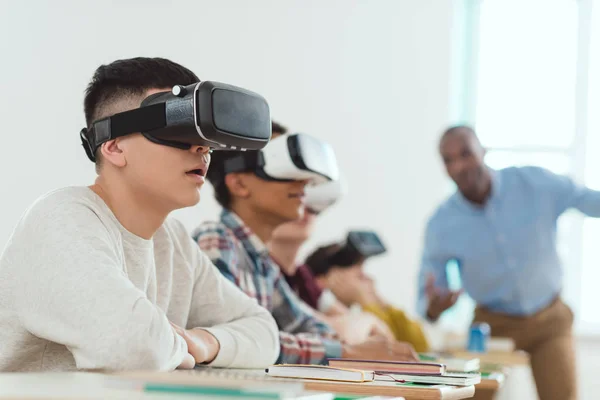Gone are the days when visualizing reality was confined only to what our eyes could see. With the arrival of AR and VR, it is now possible for us to step into the future of technology. It allows you to feel reality with your vivid imagination, where the boundaries between the physical and digital worlds blur. But have you ever given a moment of thought to the fact about what sets these two apart? What is AR vs VR all about? Well, most of us haven’t. No worries, let’s get into the nitty-gritty of this discussion through this blog.
So to get to the differences , we first need to know about what is AR and what is VR distinctively.
What is AR and VR?
AR stands for Augmented Reality. It is basically an interactive experience that consists of the integration of digital information with the user’s environment in real-time. Virtual elements like images, videos, or 3D models form an important part of AR.
As the name already suggests, VR stands for Virtual Reality. It is defined as “a computer-generated environment with scenes and objects that appear to be real, making the user feel they are immersed in their surroundings.”
Now that we at least have a rough idea of what both of these things distinctively mean let’s get to the differences between them.
AR vs VR: Learn the Differences
Both AR and VR are significant parts of today’s digital life. However, learning about the subtle differences between them will help you use them in a better way. So, here are the details about AR vs VR below.

Hardware requirement:
AR in general are accessible through everyday devices like smartphones and tablets equipped with cameras and sensors. Infact, users can use AR applications even through mobile apps, without the need for specialized hardware beyond their mobile device.
This is totally different for VR. Infact hardware requirements are one of the primary things which makes the AR vs VR tussle more prominent. VR experiences typically require specialized headsets that cover the user’s field of view, providing a seamless and immersive viewing experience. These headsets range from standalone devices to high-end systems powered by PCs or gaming consoles, offering varying levels of immersion and performance.
Interaction Experience:
Well, there is a subtle way in which the interaction experience through these two media differs. Let’s give a look at another point, that would help in solving the existing confusion about AR vs VR.
AR enables users to engage with digital content while remaining grounded in their physical surroundings. This allows users to see both the real world and digital overlays simultaneously, allowing for interaction with virtual objects while maintaining awareness of their surroundings.
VR on the other hand creates entirely virtual environments that disconnect users from the real world. Users wearing VR headsets, about which we talked previously, are immersed in a digital world, unable to see or interact with their physical environment without removing the headset.
Immersive Experience:
While both AR and VR offer immersive experiences, there is a difference in the degree of immersion in both of them.
AR offers a semi-immersive experience where virtual elements augment the user’s perception of reality. Users can see virtual objects overlaid with their surroundings, but their focus remains on the real world.
In contrast, VR provides a fully immersive experience that transports users to virtual environments. It transports us to a virtual world, as it effectively replaces the real-world surroundings with digital simulations. Users feel as though they have been transported to another reality, with limited awareness of the physical world.
This point of difference is another pillar of making the discussion of AR vs VR more prominent.
Applications and Uses:
AR is primarily used for navigation purposes . The AR navigation apps help in guiding a person through unknown cities. They give real-time directions which makes it easier to find ways without the need of checking the map constantly.
Are you tired of second-hand guessing at furniture selections? Well, AR has your rescue. It provides the facility of virtual try-on experiences so that one can safely select the best option for their needs.
AR has also proven its way in the field of marketing. It transforms advertisements into interactive experiences. Point your phone at a billboard, and suddenly, characters leap out. That’s how AR is slowly replacing static ads.
Now let’s take a look into what VR has to offer us
VR gaming is an enthralling experience in itself. It takes you out of reality, be it battling dragons, exploring ancient ruins or anything else.
VR simulations provide realistic training environments for pilots, surgeons, and other professionals, allowing them to practice skills and scenarios in a safe, controlled space.
Dreaming of far-off destinations? VR takes you on virtual tours of famous landmarks, exotic locations, and historical sites, allowing you to explore the world without leaving your home.

Final words:
To summarize the whole concept of AR vs VR , we come to a very basic point. While AR enhances your real-world experiences by adding digital layers to your surroundings, VR transports you to immersive virtual environments, opening up endless possibilities for exploration, learning, and entertainment.
In simple words, AR is a reality enhancer, whereas VR is a reality escape. But both these technologies offer exciting and interactive experiences that blur the line between the physical and digital worlds.
FAQs: AR vs VR
What devices do we need for VR?
VR experiences typically require specialized headsets that cover the field of view, thus providing an immersive viewing experience.
Does AR enhance navigation?
AR navigation apps provide real-time directions by overlaying route information onto your surroundings, making it easier to find your way without constantly checking maps.
AR can be used for online shopping. Do you agree?
Yes, AR experiences allow us to visualize how furniture or clothing will look in the space before making a purchase.



Comments 0